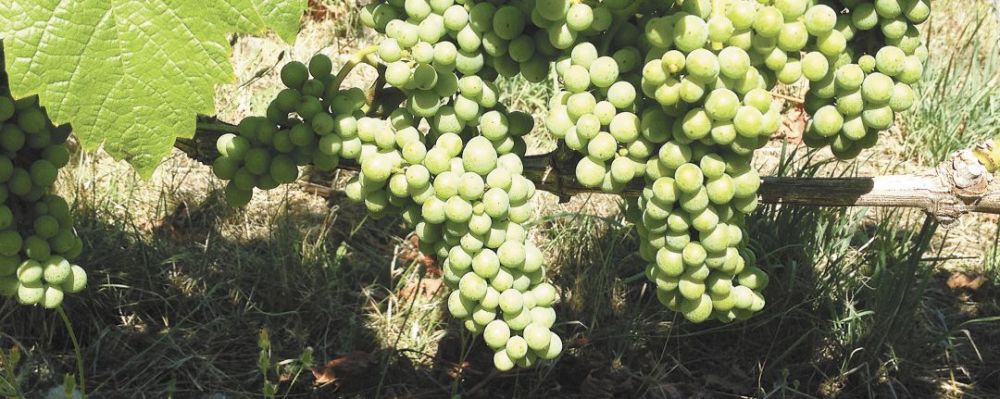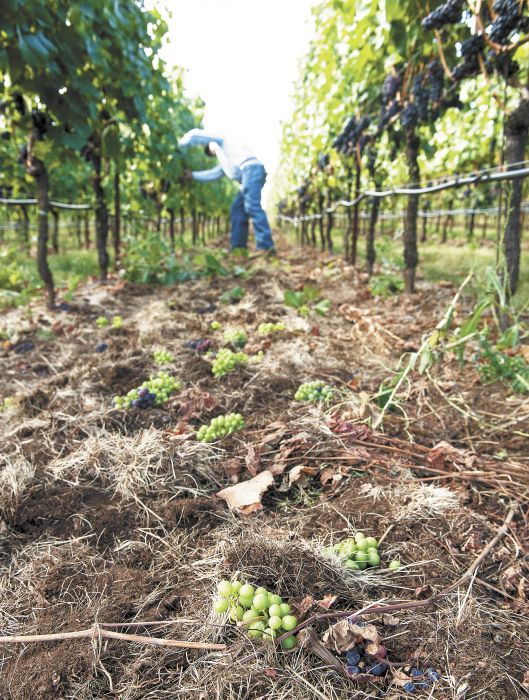Green on the Ground
Thinning fruit essential to vineyard management


By Jessica Cortell
Clusters, shoots, green drop, wings, shoulders, thirds… What is all this talk about? At this time of year, in many Oregon winegrape vineyards, dried clusters of grapes are littering the ground. For an outsider seeing a lot of fruit being dropped is surprising. Why would anyone want to thin fruit off anyway?
Fruit thinning is common in cool-climate regions such as the Willamette Valley. There are different approaches and philosophies; however, the goal is to improve fruit quality and ripening of the crop. Thinning strategies can be qualitative to improve the uniformity of ripening, to remove split, diseased or damaged fruit, or to “debunch” clusters so they don’t touch, but instead hang freely with sufficient air flow to reduce the potential of rot. Quantitative thinning is also done where the crop load the vine is carrying is adjusted.
Qualitative thinning strategies to improve the uniformity of ripening might involve removing wings and thirds or doing a green drop. Wings and thirds bloom later and also turn color later. In our cool climate, they are often removed as they frequently have less color, higher acidity, and less desirable flavors, aromas and tannin structure; but not always. Some winemakers like to keep the wings in a hot vintage particularly in white varieties to help retain acidity. Some varieties or clones have more wings than others.
The removal of thirds refers to clusters on the third position up the shoot. Typically, Pinot Noir has two clusters per shoot, but sometimes it has three clusters per shoot in a year with good fruitfulness. Some varieties, such as Gamay Noir, can have up to three to four clusters per shoot.
Fruitset refers to the number of flowers that were fertilized and form berries. Pinot Noir commonly has about 30 percent fruitset in the Willamette Valley but can be higher when there is warm, sunny weather during bloom. This year, many vineyards had both good fruitfulness and also good fruitset resulting in higher yields in both quantity and size of clusters.
How much fruit to drop and when to drop it? These are challenging decisions winegrowers must make. This year, we had a warmer-than-average summer and are running a couple weeks ahead of schedule in grape ripening. The fruit started turning color (veraison) at the start of August instead of the third week or end of August, as is typical. Decisions need to be made on what crop load the vines can carry to maximize yield and wine quality. In a cool vintage, the decision is simple, at least from a winemaker’s point of view: drop fruit to low yields to ensure it ripens fully. In a hot year, it is a little trickier to decide how much fruit should be thinned.
Growing Vocabulary
Green Drop: Process of thinning out the lagging clusters, wings or shoulders that are still green when the rest of the fruit has turned color.
Wings: Side branch on a grape cluster that can be either a tendril or a small cluster of berries.
Thirds: Cluster in the third position up a shoot.
Veraison: Time at the start of ripening when the fruit turns color.
Fruitset: Number of fertilized berries per number of flowers in a cluster.
Fruitfulness: Number of clusters per shoot.
Lag Phase: Second stage of ripening where the seed matures and berry enlargement temporarily stops.
This year, many growers are trying to maximize wine quality by leaving a little more fruit hanging to help slow the ripening process. This can work by allowing the fruit to hang longer on the vine while the flavor and aroma compounds evolve, and the tannins modify and soften without the sugars spiking and acids plunging. This risk of leaving too much fruit is that the weather in September and October can quickly change. For example, last year it was also warmer than average but suddenly things changed when major rains fell in September.
The balancing act involves adjusting the crop load based on the vintage, climate, vineyard site, health of the canopy and winemaking strategies. The crop load can be adjusted shortly after fruitset in young vines or weak blocks as leaving the fruit on the vine can quickly pull carbohydrates away from the rest of the vine and have negative consequences the following year. On mature and more vigorous vines, the crop load can be adjusted after lag phase when yield estimates are often done.
Lag phase lasts only about seven days for Pinot Noir, so it is a short window for growers to get out in the vineyard to count and weigh clusters. The basis of the process is that the clusters will double from lag phase to harvest. Growers can decide on a fruit-thinning strategy once they have calculated their lag phase estimates to adjust the crop load to the desired levels. This year, due to the anticipation of large clusters, more growers are choosing one cluster per shoot.
Some sites have yields as high as five to seven tons an acre. For growers targeting three tons per acre or less, this means a lot of green fruit is landing on the ground. While it might be tempting to keep all that lovely fruit on the vine, experienced growers and winemakers know better. The difference could be a wine that makes the reserve selection or not.

 Jessica Cortell received an M.S. degree in horticulture and a Ph.D in food science and technology from OSU. She owns Vitis Terra Vineyard Services and teaches at the Northwest Viticulture Center in Salem.
Jessica Cortell received an M.S. degree in horticulture and a Ph.D in food science and technology from OSU. She owns Vitis Terra Vineyard Services and teaches at the Northwest Viticulture Center in Salem.





